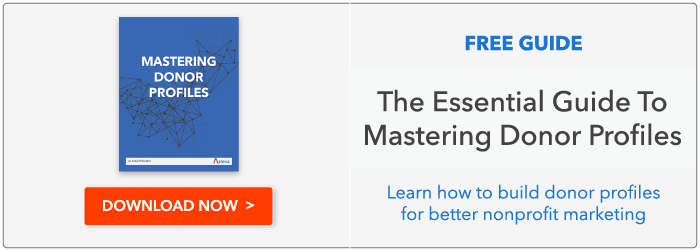How Nonprofits Combine Donors & Social Media to Improve Fundraising

Better relationships with donors begin with understanding what motivates them. It’s the main reason successful nonprofit organizations use and maintain donor profiles.
Knowing the behavioral makeup of your constituents, and the ability to segment these characteristics, lets you effectively tell stories that inspire giving. Donor profiles also help you find ways to have a presence where your supporters spend time. Today, that’s likely to be online.
Social media and donor profiling: a perfect match
There are few things more important than cultivating relationships with donors. They’ve expressed their support by giving to your organization. And social media has been a boon to nonprofits – it’s never been easier to maintain relationships with constituents.
By its very nature, social media is a way to profile people. Individuals use it to find and interact with others who share their beliefs. With permission, a donor’s personal network can become an extension of your connection to people just like them. It is the perfect complementary tool to a donor profile database.
You can select a segment of your constituents based on a profile characteristic that they share. And by communicating with them using social media, you also connect with like-minded people in their respective social networks.
Donors validate your message
Your donors’ social networks are a valuable resource to scoop up potential supporters with similar profiles. But you want to start the relationship with a warm introduction to these people.
A prospect will be more receptive to your request to give if someone they know endorses the message. And you know just the person. Peer recommendations are highly effective ways to expand your reach.
The American Red Cross uses Facebook to reach new supporters with this method. Thousands of people share this organization’s posts, and the audience has a higher propensity to respond because the message is coming from someone they know. In many cases, it’s an existing donor.
Sharing impact
There’s a lot of diversity in your donor database, but there’s one thing they all share: They want to know their contribution is making a difference. They need you to show them the impact. And there’s no better showcase vehicle than social media.
You run the risk of losing supporters – and access to their respective networks – if you don’t share your organization’s progress as a result of contributions. This is especially true with young supporters. Seventy-eight percent of those surveyed say they’d likely discontinue their support if they didn’t feel their money is making an impact.
A great example of reaching out to donors and people who share their motivations to give is the nonprofit charity: water. This organization uses Pinterest to post daily photos of how contributions have been specifically used to improve someone’s life.
Relationship Management in the Age of social networks
Cultivating long-term relationships with constituents starts with understanding why they support you. That’s at the core of a donor profile program. What this insight, you can determine the most effective storytelling that will fuel motivation and retain their interest.
Many nonprofits have turned to fundraising software to help them with the task of profiling. That’s the direction you should take too if you don’t have a donor profile program in place.
Relationship management software analyzes your donor database and mines it for patterns. Those patterns give you insight into behavior and motivation. And it’s your donor profile database that will filter the appropriate social media credentials to reach the right people with the right message.
Learn more about how fundraising software can help you master reaching your supporters and their networks here.


